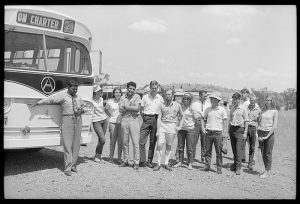6 Modern History: The changing world order activities
1. The rise of digital activism: Can clicks create change?
Tayla Hilton
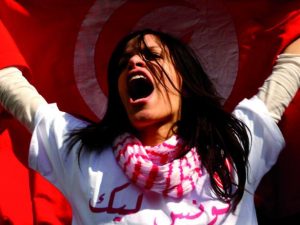
Photo by Hamideddine Boual via Baripedia (CC BY SA 4.0)
| Curriculum context | Unit 2 Modern History, Area of Study 2 (VCAA, 2020) |
| Historical thinking concept/s | Identify continuity and change |
| Historical context | Social and Political Movements > the Lord’s Resistance Army (KONY2012), Boko Haram (#Bringbackourgirls), Black Lives Matter and Arab Spring |
| Learning intentions | Identify the goal of a social and political movement campaign that uses digital technologies.
Analyse the extent to which the campaign was effective in initiating and implementing change. |
Activity
This activity challenges you to unpack one of four digital social movements to understand why these movements came about and what, if any, change occurred in society. More specifically, by the end of this activity you will be able to identify the intended purpose of a social and political movement campaign that uses digital technologies. Understanding this type of change in our society helps us address the Unit 2 curriculum requirements and also gives you tools for analysing the world around you now and in the future.
The four digital social movements, KONY2012, #BringBackOurGirls, Black Lives Matter and the Arab Spring all relied on social media to progress their message, which, in the early and mid 2000s was a lot less common than the number of viral tiktoks today!
Part 1
Your job is to first work independently to research the digital social movement you have been allocated. During this time, you should use the table to frame your thinking and learning. Don’t forget, there are a variety of perspectives to consider historical events from. The work goal for this time is to populate at least the first 4 rows (left side) of the table. The table can be a draft that you add to and edit over time as you uncover more about your movement.
Here are some resources to get you started, however you are free to use whatever resources you find during your research. Use your previous knowledge of primary and secondary sources to ensure you use a variety of high-quality sources. You can also use YouTube, podcasts, articles, websites etc.
KONY2012
Kony 2012: What’s the real story?
#BringBackOurGirls
Boko Haram’s kidnapping of 276 girls and its aftermath, explained
Black Lives Matter
Arab Spring
Part 2
Now you will join your peers that have been researching the same digital movement as you. During this time you will work through the questions in the table below to compare your research and learning with the others in the group. There are additional questions at the bottom of this table to help with the discussion. The goal of this part of the lesson is to find out what perspectives your peers have on the event. You should add any new knowledge or perspectives to your notes.
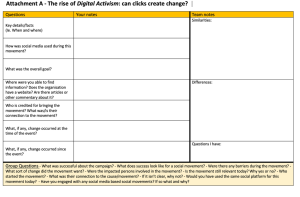
References
ABC (2012) Who is Kony? Behind the News, accessed 25 July 2022.
BBC (n.d.) Arab uprising: country by country, BBC News, accessed 25 July 2022.
#BringBackOurGirls (2022) Bring Back Our Girls accessed 25 July 2022.
Curtis, P & McCarthy, T. (2012). Kony 2012: what’s the real story? accessed 25 July 2022.
Houissa, L. (2022) Arab Spring: A research and study guide, Cornell University, accessed 25 July 2022.
Museum of Social Justice (2021) Black Lives Matter for Kids, accessed 25 July 2022.
Proulx, N. & Schulten, K. (n.d.) Teaching Ideas and Resources to Help Students Make Sense of the George Floyd Protests, The New York Times, accessed 25 July 2022.
VCAA [Victorian Curriculum and Assessment Authority] (2020) VCE History Study Design, accessed 27 July 2022.
Vox (2015). Boko Haram’s kidnapping of 276 girls and its aftermath, explained accessed 25 July 2022.
2. Women’s movements in the 20th century: Timeline
Merjem Colan
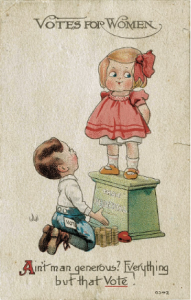
Suffrage postcard 1916, Wikimedia Commons, Public Domain
| Curriculum context | Unit 2: Movements for Change in the 20th century, Australian Curriculum Version 8.4 (ACARA, n.d) |
| Historical thinking concept/s | Sequencing chronology
Using historical sources as evidence |
| Historical context | Women’s movements 20th century |
| Learning intentions | Identify and sequence key events in chronological order.
Develop the historical skills to judge the reliability and usefulness of a source. |
Activity
In the 20th Century, women’s movements were happening simultaneously across the globe. Your group’s task is to create a timeline that identifies key moments in the development of these movements. Each group will take a period of time and will then combine their section of the timeline to the other sections to create a whole class timeline. See these examples from the ABC and the United Nations.
The class needs to decide on the format of the timeline and all use the same format, so the timeline sections can be combined. For example, digital tools such as Canva (see timeline infographic templates), XMind, Tikitoki or Office Timeline templates in PowerPoint.
Find at least one historical source for each key event (see examples below). This timeline will become a working document for us to continue to add key events, individuals, and dates as we learn about women’s movements of the 20th Century.
Historical periods:
- First-wave feminism and suffrage movement (late 19th – early 20th century)
- The world wars (1914-1945)
- Post-war period (1946-1959)
- Second-wave feminism (1960-1989)
- The millennium (1990-2010)
Your timeline should include examples of:
- Legislation that helped secure changes for women and legal and political entitlements of women (e.g. right to vote)
- Key events
- Key contributors (groups and leaders) to the women’s movement
- Key social, political, legal and technological developments
Sources that can be used include, but are not limited to:
- Photographs
- Newspaper articles
- Diary entries
- Interviews
- Recordings
- Songs
- Cartoons
- Political posters
- Quotes
References
ABC (2012) Timeline: the women’s movement accessed on 12 September 2022.
ACARA (n.d) Unit 2: Movements for change in the 20th Century accessed on 12 September 2022.
UN Women (n.d) Women of the world unite! accessed on 12 September 2022.
3. Women’s movements in the 20th Century: Diary entries
Merjem Colan
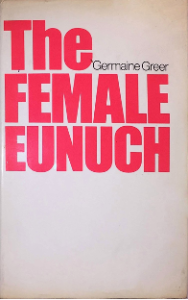
The Female Eunich (1970) by Germaine Greer, Wikimedia Commons, Public Domain
| Curriculum context | Unit 2: Movements for Change in the 20th Century, Australian Curriculum Version 8.4 (ACARA, n.d) |
| Historical thinking concept/s | Using historical sources as evidence
Determining historical significance |
| Historical context | Women’s movements in western societies in the 20th Century |
| Learning intentions | Use historical sources to construct a narrative/argument.
Identify key events that led to major events in the Women’s movements of the 20th Century. |
Activity
Using the events and sources identified in the timeline activity above, pick an event you think is historically significant to the women’s movement during the 20th Century and imagine what it was like experience it.
For example:
- You could be a personal friend of Jane Roe, the plaintiff of the Roe vs Wade (1973) case. Your diary entries will include key events that were happening surrounding that trial and reflections on the social attitudes and beliefs in this context.
- You could have just read Germaine Greer’s Female Eunuch (1970). Write the dialogue for a conversation that show different perspectives about women’s liberation in the early 1970s.
Write a 500-word letter, diary entries, dialogue for a conversation or short article for a woman’s magazine sharing a historical perspective as a fictional character (any gender). Use time-specific vocabulary and write as though you are living in the 20th Century during a period of social change. Show that you have drawn on a few historical sources and real events, groups, individuals and/or ideas.
References
ACARA (n.d) Unit 2: Movements for change in the 20th Century accessed on 12 September 2022.
4. Investigating the role of the media in civil rights movements
Tamsyn Pentland
SAFA protesters standing alongside bus [Left to right:] Gerry Mason, Pat Healy, Sue Reeves, Charles Perkins, Ray Leppik, Bob Gallagher, Ann Curthoys, John Butterworth, Norm McKay, Alan Outhred, [unidentified], Colin Bradford, Louise Higham. 1965, Unknown author, Wikimedia Commons and Mitchell Library, State Library of New South Wales, Public Domain
| Curriculum context | Unit 2 Modern History, Area of Study 2 (VCAA, 2020) |
| Historical thinking concept/s | Ask and use historical questions
Analyse cause and consequence
|
| Historical context | Civil rights movements in Australia and the United States |
| Learning intentions | Evaluate the role of the media in influencing social and political movements and to understand how different movements influence change.
Ask and use historical questions surrounding the Freedom Rides movements. Understand the motivation for civil rights change in Australia. |
Activity
To begin with, everyone is to listen to this 1965 recording, Freedom Rides Bus Tour Through Rural NSW with Charles Perkins and discuss:
- What historical perspectives are expressed in this recording?
- What evidence is there of racial segregation in the town of Moree?
- How might these tensions have been reported in the local paper in 1965?
In this activity you will access primary sources and determine the value of different media sources for influencing social change in different civil rights movements. For Part A of the activity you need to answer and create literal, inferential and evaluation questions to develop your historical thinking (Whitehouse JA 2019:61). Use these questions to compare the historical contexts of the Freedom Rides in the USA and New South Wales (NSW) and consider the role of media coverage of the American Freedom Rides in influencing the Australian Freedom Rides movement.
Part A
Media sources can be located using the National Library of Australia’s Trove.
Here are some examples:
Freedom Riders Change Tactics 1961 (USA)
Segregation 1962 (Australian perspective on USA)
Freedom riders pose problem for the South 1961 (USA)
The other side of the creek 1965 (NSW)
Aboriginal Leader: A militant champion of equality 1965 (NSW)
Heroic Story of Freedom Ride 1965 (NSW)
If you would like to challenge yourself to find your own newspaper article to analyse you can use these key search terms:
- Freedom Riders
- Segregation Boycott movement
- Freedom rides America
- Freedom rides 1965
And these key filters:
- Newspaper and Gazette articles
- 1960-1969
- NSW and Canberra newspapers
Literal questions
- Where is the news source from?
- How are the Freedom Rides described?
Inferential questions
- Who was Charles Perkins and what was his role in the Australian Freedom rides?
- How were the political and social climates in America and Australia similar and different?
Evaluation questions
- How significant was the Australian Freedom rides in inspiring both immediate and long-term change to the treatment of First Nations Australians?
- How important was the media in inspiring movements and change in the 1960s?
Part B
After you have completed these questions, create three of your own questions about your source using the literal, inferential or evaluation format. Then exchange your questions and source with another student in the class and complete their set of questions.
References
ABC (2019) Freedom Rides Bus Tour Through Rural NSW accessed 27 July 2022.
NLA (n.d) Trove. National Library of Australia, accessed 27 July 2022.
VCAA [Victorian Curriculum and Assessment Authority] (2020) VCE History Study Design, accessed 27 July 2022.
5. Key events in the lead up to the Rwandan Genocide
Tyson Coverdale
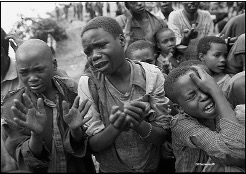
Children living through the Rwandan Genocide by Gil Serpereau, Flickr (CC BY-NC-SA 2.0)
| Curriculum context | Unit 2 Modern History, Area of Study 2 (VCAA, 2020) |
| Historical thinking concept/s | Analyse cause and consequence
|
| Historical context | Regional Conflict > The Rwandan Genocide |
| Learning intentions | Identify the key events that led up to the Rwandan Genocide.
Formulate links between each event and how they triggered the genocide. Create a timeline to apply context to the events predating the Rwandan Genocide. |
Activity
In this activity you will work in pairs or small groups to investigate one of the defining events that led up to the Rwandan Genocide. Using the source provided and your own research you will create a poster on one event before the 7th of April 1994. Your group will give a short explanation of your event and its significance in terms of cause and consequence. The posters will be displayed in the classroom in chronological order to create a timeline for all students to be able to see and utilise. We will then use the timeline to analyse the combined causes and consequences of these key events and evaluate which were the most significant.
- Using this timeline resource, Outreach Programme on the 1994 Genocide Against the Tutsi in Rwanda and the United Nations, select a significant event or development predating the 7th of April 1994 to be the basis of your poster. Make sure no other groups are doing this event.
- As a group read through the section of the source regarding your topic and note down the date that the event occurred and who was involved in the event. You will need to do your own research into the event and print off some images for your poster/timeline section. Within your group discuss the significance of your chosen event when it comes to the genocide that followed.
- All groups need to line up with their posters in chronological order and explain how their event contributed to the development of the conditions that caused the genocide in Rwanda. Display the posters around the room and watch this video How could the Rwandan genocide happen? – BBC Africa
- Download the Cause and Consequence template from The Historical Think Project website and complete it using the information from the timeline and the video.
References
BBC (2019) How could the Rwandan genocide happen? – BBC Africa accessed on 25 July, 2022.
Historical Thinking Project (n.d) Historical thinking concept templates accessed on 25 July, 2022.
The United Nations (2022), ‘Outreach Programme on the 1994 Genocide Against
the Tutsi in Rwanda and the United Nations’ accessed on 25 July, 2022.
VCAA [Victorian Curriculum and Assessment Authority] (2020) VCE History Study Design, accessed 25 July 2022.
6. Asking questions about the Bandung African-Asian Conference
Rebecca Cairns
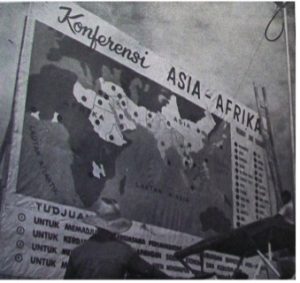
Bandung Poster Bandung Bulletin, picryl, Public Domain
| Curriculum context | Unit 2 Modern History, Area of Study 2 (VCAA, 2020) |
| Historical thinking concept/s | Ask and use historical questions |
| Historical context | Decolonisation and self-determination movements > Bandung Asian-African Conference, 1955 |
| Learning intentions | Identify key features of the Bandung Conference and the sorts of ideas it promoted regarding challenging established structure of power within decolonising nations.
Answer and formulate literal, inferential and evaluative questions. Synthesise knowledge and questioning skills to frame historical questions about a decolonisation/self-determination movement in a specific nation. |
Activity
In this activity you will work in pairs or small groups to find out about the Bandung Asian-African Conference in 1955 to answer three types of questions using source 1. Then you will apply these question types to formulate a set of questions about either source 2 or source 3. Once your group has developed a set of questions, swap them with a group that developed questions about a different source and answer the questions.
Question types
Literal questions: also called understanding or surface level questions, these questions require you to gather facts and information explicit in the source (DET, 2022, 2021)
Inferential questions: also called analysing questions, these questions require you to analyse and interpret different parts of the source by reading between the lines to examine what is not explicitly stated (DET, 2022, 2021)
Evaluative questions: also called evaluating questions, these bigger picture questions require you integrate your own knowledge and experiences with your evaluation of the source (DET, 2022, 2021)
a) Use Source 1 Explainer: History of the Asian-African Conference lives on to answer these questions
Literal questions
- What anniversary did Indonesia celebrate in 2015?
- How many countries were represented at the conference? Name some of them.
- Who was Indonesia’s president at the time?
Inferential questions
- Why would the conference be calling for peaceful co-existence at this particular moment in time?
- The conference introduced the term ‘third world’ – why might this term have been replaced with ‘developing countries’?
- Why has the conference been described as a turning point for decolonisation movements?
Evaluative questions
- Considering where this source is published and who it is authored by, is it likely to be an accurate and reliable interpretation?
- What is your initial evaluation of the significance of this event in relation to the development of decolonising movements in Africa and Asia?
b) Choose Source 2 or 3 and develop your own set of eight questions using the different types of questions
Source 2 Revisiting the 1955 Bandung Asian-African Conference and its legacy
Source 3 The History of the Asian-African Conference
c) Swap your group’s questions with another group’s and answer them.
d) In your groups, develop at least three historical questions that could be used to guide further research about decolonisation in Asia and Africa.
References
Choiruzzad, S. A. B. (2015, April 20) Explainer: History of the Asian-African Conference lives on. The Conversation, accessed 10 July 2022.
Department of Education and Training (2022) Reading, interpreting and analysing History sources. Victorian Government, accessed 10 July 2022.
Department of Education and Training (2021, July 27) Comprehension, Victorian Government, accessed 10 July 2022. Museum of the Asian-African Conference (2022). The History of the Asian-African Conference, accessed 10 July 2022.
The South Centre (2015) Revisiting the 1955 Bandung Asian-African Conference and its legacy, accessed 10 July 2022.
VCAA [Victorian Curriculum and Assessment Authority] (2020) VCE History Study Design, accessed 10 July 2022.
7. Reporting from Bandung: Surkano’s opening address
Rebecca Cairns
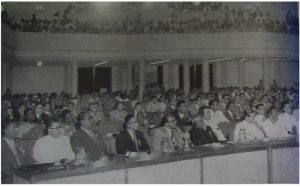
Delegates at the opening meeting of the Bandung Conference by Foreign Ministry of the Republic of Indonesia, Wikimedia Commons, Public Domain
| Curriculum context | Unit 2 Modern History, Area of Study 2 (VCAA, 2020) |
| Historical thinking concept/s | Explore historical perspectives |
| Historical context | Decolonisation and self-determination movements > Bandung Asian-African Conference, 1955 |
| Learning intentions | Understand the ideas and perspectives expressed by President Surkano in his opening address.
Understand Surkano’s role in the decolonisation of Indonesia. Appreciate the historical perspective of a nation represented at Bandung. |
Activity
This activity challenges you to use your historical imagination by taking on the perspective of a journalist from one of the invited countries at the opening session of the Bandung Conference on April 18, 1955. In his address President Surkano, says, “colonialism is not dead.” Why does he believe this? What does he think can be done about to help decolonise African and Asian countries? Why is he hopeful?
Your job is to report back to your home nation about the sort of perspectives President Surkano expresses about colonialism in his opening address. You will need to select the Asian or African nation you are representing and choose one of the following formats to report back to your fellow citizens:
- Write a 500-word report for radio about Surkano’s perspective on colonialism and record your report (approximately four minutes) using a voice memo or recording app. If you prefer you can work in pairs and record the radio report as an interview. Select a few powerful direct quotes from the address to include in the report.
OR
- Write a 500-word newspaper article about Surkano’s perspective on colonialism. Present it as a newspaper article may have looked in an English language newspaper in that country in 1955 (see example below). Select at least one image (from the public domain/with a Creative Commons) to go with the report. Select a few powerful direct quotes from the address to include in the report.
Use the following resources to help write your report:
- Watch the first two minutes of the address on You Tube.
- Read the Opening Address given by Sukarno (Bandung, 18 April 1955)
It is not necessary to read the whole address, skim over the start and focus on the following sections:
- page 4: what he says about colonialism
- page 5: where he asks “What can we do?”
- Page 8: his reasons to be hopeful
Find some other sources of information about President Surkano’s role in Indonesian independence prior to 1955, so you can include some background information about him in your report.
Example of a 1955 newspaper article: To see an example of a real newspaper article from the time, scroll down to the article from the West African Pilot on this page.
Optional: You could also include some comparison about the perspectives the leaders in your selected countries have about colonialism and decolonisation. Consider if they would be likely to embrace Surkano’s perspective.
Whole class activity: Read and listen to the reports from the other ‘journalists’ in your class. Discuss how and why their interpretations are similar or different to your own analysis of the source.
References
CVCE (2022) Opening address given by Sukarno (Bandung, 18 April 1955), accessed 10 July 2022.
McCann, G. (2018) Ghana’s Bandung moment: Jim Markham’s Asian sojourn, 1953–55, Afro-Asian Visions, accessed 10 July 2022.
Timescape Indonesia (2013). President Sukarno Opening Speech at, the Bandung Conference, 1955, Indonesia, You Tube, accessed 10 July 2022.
VCAA [Victorian Curriculum and Assessment Authority] (2020) VCE History Study Design, accessed 10 July 2022.
8. Indigenous rights and the world stage: How international civil rights movements are reflected in Australia
Chris Mayman
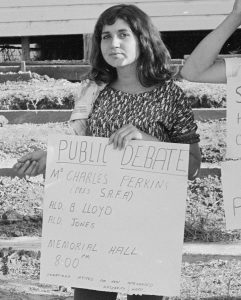
Center protester detail with sign from Student Action for Aborigines protest outside Moree Artesian Baths 1965 – The Tribune, Wikimedia Commons licenced by Flickr the Commons, Public Domain
| Curriculum context | Modern History Stage 1, SACE |
| Historical thinking concept/s | Ask and use historical questions |
| Historical context | Indigenous Peoples > Indigenous Civil Rights Movement |
| Learning intentions | Identify key features in the indigenous rights movements in Australia and connect them to global civil rights movements, particularly in commonwealth countries.
Develop an understanding of why some forms of political action are more effective than others in Australia as compared to the rest of the world. Demonstrate their ability to draw connection between separate but parallel events |
Activity
In this activity, you will be researching and developing your ability to draw connections between separate events. You will analyse and describe the relationships between the Australian indigenous rights movement and other racially defined rights movements such as the civil rights movement of America, indigenous rights campaigns of New Zealand and Canada, the end of Apartheid in South Africa, etc. This includes examining what forms of political activism were being used, to what effect and developing your own ideas of why some forms of activism and protest have been more or less effective in different times, movements and places.
You are to use this research to create a presentation of the differences, similarities and relationships between Australia’s and another racially defined civil rights movements of the modern era from around the world as well as the relationship between European settler societies and the racial minorities. Each student is to choose a different country and discuss how and why the relationship between the dominant cultures and the racial minority cultures may be different by looking at the civil rights activism in these nations.
Resource 1 The Freedom Riders: Australian and American Civil Rights
Resource 2 Indigenous Affairs in Australia, New Zealand, Canada, United States of America, Norway and Sweden
Resource 3 COLLABORATING FOR INDIGENOUS RIGHTS 1957–1973: The fights for Civil Rights
Resource 4 The Protection of Indigenous Rights: Contemporary Canadian Comparisons
References
Behrendt, L. (2000). The Protection of Indigenous Rights: Contemporary Canadian Comparisons. Consultant, Law and Bills Digest Group, accessed 16 August 2022.
ClickView (2015). The Freedom Riders: Australian and American Civil Rights, accessed 16 August 2022.
Dow, C. and Gardiner-Garden, J. (2022) Indigenous Affairs in Australia, New Zealand, Canada, United States of America, Norway and Sweden. Social Policy Group, accessed 16 August 2022.
NMA (2022) Collaborating for Indigenous Rights 1957–1973: Civil Rights, National Museum of Australia, accessed 16 August 2022].
SACE (n.d.) Modern History Stage 1 Indigenous peoples, South Australian Certificate of Education, accessed 16 August 2022.

